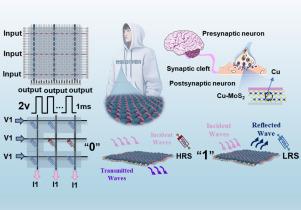Multi-scenario application of non-volatile smart invisible textiles based on copper-ion modulated MoS2
IF 13.2
1区 工程技术
Q1 ENGINEERING, CHEMICAL
引用次数: 0
Abstract
Flexible lappable memristors are ideal building blocks for designing smart fabric information processing devices, which empowers versatile integration of smart fabrics. The volatile type of memristors have certain limitations in applications and most of them suffer from random formation of conductive channels and lack certain stability. In this paper, such small-area contacts were fabricated on carbon fibers using direct solution deposition, where each interwoven fiber contact can be used as a memristor, and excellent resistive switching performance was obtained by copper atom modification, with switching ratios of up to 106, setup voltages as low as 0.8 V, and hold-up times of more than 104 s. Our systematic study demonstrates that heat treatment temperatures and copper modification can achieve a volatile-to-non-volatile transition. The textile-based memory elements successfully demonstrate synaptic plasticity under electrical stimulation, accurately emulating fundamental neural network operations. The resulting textile-type memristor arrays have high inter-device homogeneity and are capable of high-recognition accuracy image recognition and processing of complex physiological data, such as brainwave signals. Textiles can switch back and forth between wave-transparent and wave-blocking at low frequencies, effectively preventing interference between devices. This dual function of combining neuromorphic computing with filterable electromagnetic protection offers great potential for next-generation smart textile applications.

基于铜离子调制MoS2的非易失性智能隐形纺织品的多场景应用
柔性可折叠忆阻器是设计智能织物信息处理设备的理想构建模块,可实现智能织物的多功能集成。易失性忆阻器在应用上有一定的局限性,大多数忆阻器存在导电通道随机形成和缺乏一定稳定性的问题。本文采用直接溶液沉积的方法在碳纤维上制备了这种小面积触点,其中每个交织的纤维触点都可以用作记忆电阻器,并且通过铜原子修饰获得了优异的电阻开关性能,开关比高达106,设置电压低至0.8 V,保持时间超过104 s。我们的系统研究表明,热处理温度和铜改性可以实现挥发性到非挥发性的转变。基于织物的记忆元件成功地展示了电刺激下的突触可塑性,准确地模拟了基本的神经网络操作。所制备的纺织型忆阻器阵列具有较高的器件间均匀性,具有较高的图像识别精度和脑电波信号等复杂生理数据的处理能力。纺织品在低频时可以在透明波和阻隔波之间来回切换,有效地防止了设备之间的干扰。这种将神经形态计算与可过滤电磁保护相结合的双重功能为下一代智能纺织品应用提供了巨大的潜力。
本文章由计算机程序翻译,如有差异,请以英文原文为准。
求助全文
约1分钟内获得全文
求助全文
来源期刊

Chemical Engineering Journal
工程技术-工程:化工
CiteScore
21.70
自引率
9.30%
发文量
6781
审稿时长
2.4 months
期刊介绍:
The Chemical Engineering Journal is an international research journal that invites contributions of original and novel fundamental research. It aims to provide an international platform for presenting original fundamental research, interpretative reviews, and discussions on new developments in chemical engineering. The journal welcomes papers that describe novel theory and its practical application, as well as those that demonstrate the transfer of techniques from other disciplines. It also welcomes reports on carefully conducted experimental work that is soundly interpreted. The main focus of the journal is on original and rigorous research results that have broad significance. The Catalysis section within the Chemical Engineering Journal focuses specifically on Experimental and Theoretical studies in the fields of heterogeneous catalysis, molecular catalysis, and biocatalysis. These studies have industrial impact on various sectors such as chemicals, energy, materials, foods, healthcare, and environmental protection.
 求助内容:
求助内容: 应助结果提醒方式:
应助结果提醒方式:


